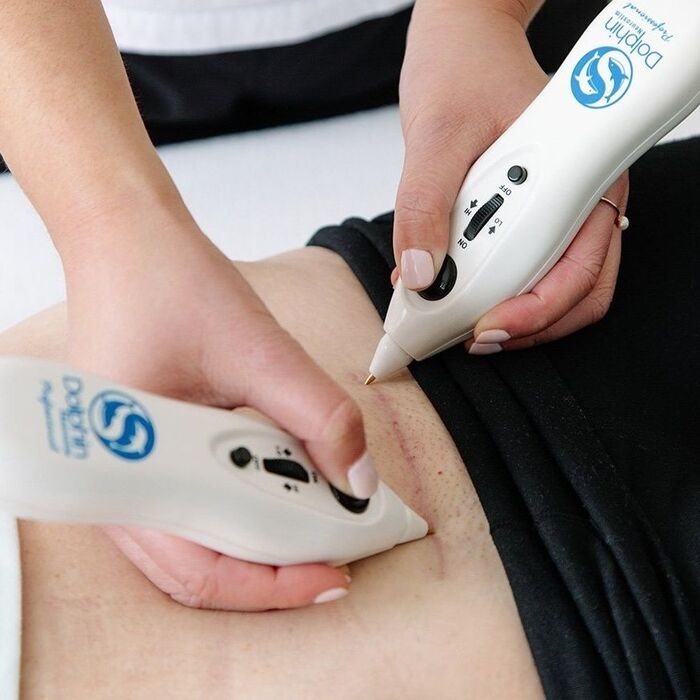PT & OT Services
Scroll down to learn more about PT, OT, and the different techniques we use at BPT
Pelvic Floor Therapy
The pelvic floor is a group of muscles within your pelvis that support your reproductive, digestive, and urinary systems. These muscles can strongly impact all surrounding tissues and joints causing pain and dysfunction.
Scroll down to learn more about pelvic floor therapy & why BPT is right for you.
Chronic Pain & Illness
Our treatment approach is built on the premise that every patient requires focused and personalized care addressing ALL body systems that are impact their function. Every appointment is private & one-on-one for the quality care you need.
Scroll down to learn more about how we treat chronic pain & illnesses at BPT.
Orthopedic & Sports Medicine
Orthopedic rehabilitation is about learning how to overcome your compensations so you can build efficient mobility, strength, and stability. 15 reps of heavy weight will only hurt you if you do it wrong.
Scroll down to learn more about how orthopedic & sports medicine rehabilitation is better at BPT.
Pelvic Floor Therapy
What to Expect during a Pelvic Floor Therapy Evaluation & Appointment:
A private, one-on-one evaluation during which the therapist reviews your medical history, symptoms & goals, and performs an external physical exam (internal only with permission). The therapist will work with you to create an individualized plan including exercises, stretches, manual therapy, biofeedback therapy, etc. The number of therapy visits needed will vary case-to-case. Each session is customized to address your needs, symptoms, and history.
Pelvic Floor Primary Functions:
Support pelvic organs (including the bladder, uterus, prostate and rectum).
Stabilize the pelvis and spine.
Assist with sexual function.
Support bowel and bladder control.
Assist in regulating internal pressure and breathing.
Pelvic floor muscles are similar to other muscles in the body. They can be weak, strained/over-stretched, strong, stiff, or tight. Pelvic floor weakness, stiffness, or tension leads to pelvic muscle dysfunction.
Why Choose BPT for Pelvic Health Therapy?
The complexity and sensitivity of pelvic health conditions requires focused treatment emphasizing the following:
• Privacy
• Thorough communication
• Full system/whole patient evaluation
• Continuous assessment and adjustment to treatment plan
• Empathy & compassion for how burdensome these conditions can be.
Diagnoses That Pelvic Floor
Therapy Can Help With
Pre& Post-Natal Care
Bladder Diagnoses:
Urinary Leakage (Incontinence)
Urinary frequency and urgency
Painful urination
Bowel Diagnoses:
Stool Leakage (incontinence)
Stool urgency and frequency
Painful bowel movements & Constipation
Pain Diagnoses:
Abdominal pain
Pain with intercourse (Dyspareunia)
Pain associated with pregnancy/postpartum
Pelvic pain (including back, hip, buttock, sacroiliac joint, tailbone, genital, perineal, and anal pain)
Vulvodynia
Testicular or penis pain
Other Diagnosis:
Nerve Entrapment causing pain, sensation issues, or weakness in the pelvis, hips, or legs.
Prostatectomy (Removal of the prostate)
Pelvic organ prolapse
Endometriosis
Polycystic ovarian syndrome (PCOS)
Abdominal and pelvic cancers
Hypermobility Disorders
Diastasis Recti
Chronic Pain & Illness
How is BPT different than other PT CLinics?
Every patient receives private, one-on-one, focused assessments and treatments for truly individualized care. Every appointment.
We treat the WHOLE patient to restore function and eliminate or best manage their pain & symptoms. Our goal is patient independence. We aim to arm each patient with an understanding of their body’s systems and how to avoid their personal compensation patterns. We emphasize self-care techniques involved in chronic pain & illness management including nutrition, mental health, productivity schedules, leisure activities, sleep health, and healthy physical activity.
BPT Treatment Approach
Chronic Joint Pain (including back and neck pain)
Rheumatoid Arthritis (RA & JRA)
Lupus
Multiple Sclerosis (MS)
Hypermobility & Connective Tissue Disorders (EDS Spectrum, etc.)
Parkinson’s Disease (PD)
Cancer
POTS & Dysautonomia
Lymphedema
Chronic Post-Operative Pain/Dysfunction
Migraines & Chronic Headaches
Chronic Abdominal Pain (IBS, post appendectomy, cholecystectomy, etc.)
Pelvic Pain
Neuropathy
Fibromyalgia & Chronic Fatigue Syndrome
Chronic Conditions BPT Can Help with:
Orthopedics & Sports Medicine
How is BPT different than other PT CLinics?
No sharing your therapist with other patients. Your therapist is by your side guiding you through individualized exercises and activities to correct your body mechanics for optimal mobility, strength, stability, and overall function.
Your therapy sessions are 45-60 minutes of a few exercises with focused instruction ensuring that every minute of your treatment is helpful to your rehabilitation. You will not be performing 30 exercises on your own for 90 minutes. Not in this clinic.
We treat your injury as well as the CAUSE and resulting physical trauma of it. Our goal is to restore function and give you the knowledge you need to prevent further injury and perform at your best. Every person struggles with multiple areas of dysfunction and imbalances. We look at your posturing & movement patterns from center, out to identify compensations & soft tissue imbalances and give you quality, individualized care.
BPT Treatment Approach
NON-SURGICAL:
Joint Pain (ALL joints)
Muscle Injury (strain/tear)
Ligament Injury (sprain)
Impingement (shoulder, hip, etc.)
Bursitis (ALL joints)
Labral Tear (shoulder, hip)
Tendonitis (ALL joints)
Fractures (non-op)
Carpal Tunnel Syndrome
Thoracic Outlet Syndrome
Radiculopathies (Sciatica, etc.)
PRE & POST-OPERATIVE:
Joint Replacement (ALL joints)
Ligament Repairs (Ex: ACL, MCL)
Tendon Repairs (Ex: rotator cuff repair)
Back & Neck Surgeries (Ex: fusion, laminectomy)
Hernia Repair
Post PRP Treatments
Trigger Finger Repair
Carpal Tunnel Surgery
Fracture Repair
Orthopedic Issues We Treat:
Scroll on to learn more about PT & OT treatments as well as specialized techniques only at BPT.

Physical Therapy
Patient-Centered Care
Regardless of pathology, each patient struggles with multiple areas of dysfunction and imbalances. At BPT, we assess and treat the WHOLE patient to restore function and eliminate symptoms.
Every tissue in the body is connected and therefore impacts one another. Let us help you identify all components involved with your symptoms and dysfunction and teach you how to best address each one for a better, pain-free life.
BPT therapists will include the following in their evaluation, re-assessments, and treatments:
Discussion of the patient’s symptoms and dysfunction
Discussion of how a patient’s symptoms impacts their activities of daily living
Identifying the patient’s goals
Posture Analysis
Gait Analysis
Breathing Mechanics
Vertical Compression Testing
Push/Forward Functional Movements (single leg stance, sit to stand, stairs, lunge, push up, reaching).
Pull/Backward Functional Movements (stand to sit/hip hinge, step down, row, pull down).
Fascia Mobility & Scar Tissue Mobility.
Joint ROM, Joint Mobility, Muscular Flexibility, and Muscular Strength Testing.
An Appointment at BPT

Occupational Therapy
Addressing mental health
& life management
Your physical dysfunction can negatively impact your daily routines and habits (“occupations” in medical lingo) creating a vicious cycle. Luckily, OT can give you the tools you need to correct these negative behaviors for a better quality of life.
Occupations are various kinds of life activities including, but not limited to:
Activities of Daily Living
Instrumental Activities of Daily Living (ex: toileting, writing)
Rest and Sleep Habits
Education/Learning Habits
Work Activities
Play Activities
Leisure Activities
Social Activities
What Are Occupations In Occupational Therapy?
In an effort to further help our patients get back to the life they deserve, BPT welcomes Nicole Remblos-Molina, OT to address the mental health & behavioral components of your physical struggles.
Think - Therapeutic ‘Life Coach’

Neural, Vascular, & Visceral Manipulation
Osteopathic fascial techniques aim to alter the mechanical properties of fascia, such as density, stiffness, and viscosity, so that the fascia can efficiently adapt to physical stresses.
Fascia is the very large sheet of connective tissue found below the skin. This tissue attaches, stabilizes, imparts strength, maintains vessel patency, separates muscles, and encloses different organs.
Osteopathic fascial manipulations treat functional and structural imbalances within the musculoskeletal, vascular, nervous, urogenital, respiratory, digestive, and lymphatic systems.
An Osteopathic Approach
A nerve only functions optimally when it is able to move freely in its surrounding tissues. Neural Manipulation facilitates free movement of the nerves in their surroundings; that is, in relation to adjacent muscles, fascia, narrow passages in the aponeurosis, organs and bones.
neural Manipulation
Manipulation
Vascular
Compression along vascular structures creates restriction patterns and pain. Vascular Manipulation locates and releases restrictions along the vascular structures to increase blood circulation to an organ improving its function.
A form of manual therapy that focuses on the internal organs, their environment, and the potential influence on many structural and physiological dysfunctions. Visceral Manipulation treats a person's functional and structural imbalances with an aim to affect their musculoskeletal, vascular, nervous, urogenital, respiratory, digestive, and lymphatic dysfunction.
Visceral Manipulation

Craniosacral Therapy
An Osteopathic Approach
CST is the gentle, non-invasive, and hands-on treatment of the connective tissues and fluid that protect your brain and spinal cord. The human body is interconnected, both structurally and functionally. This means that one area of your body can affect another. The goal of CST is tension relief through fascial clearance. This clearance allows the nervous system to better self-regulate and heal.

Dry Needling
Dry needling is an effective way of treating myofascial trigger points (shortened and sensitized neuromuscular units that cannot release back to their normal state). Stimulating a trigger point with a needle helps draw normal blood supply back to flush out the area and release tension. It can decrease muscle tightness, increase blood flow, and reduce pain in the affected soft tissues.

Microcurrent Point Stimulation (MPS)
Microcurrent point stimulation (MPS) is a non-invasive treatment that uses concentrated direct current (DC) to treat tissue restriction. MPS is similar to acupuncture, but without needles. The MPS device locates and applies microcurrent to acupuncture points, trigger points, and scar tissue to relax muscles, decrease scar restrictions, calm the nervous system, and release endorphins.

Cupping
Suction from cupping draws fluid into the treated area. Your body replenishes the cupped areas with healthier blood flow and stimulates proper and normal healing at a cellular level.